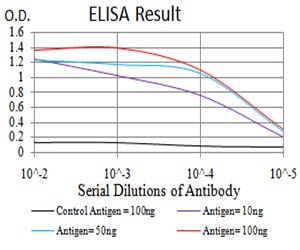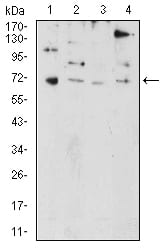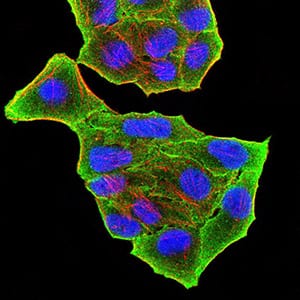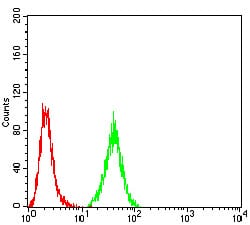



| WB | 咨询技术 | Human,Mouse,Rat |
| IF | 咨询技术 | Human,Mouse,Rat |
| IHC | 咨询技术 | Human,Mouse,Rat |
| ICC | 1/100 - 1/500 | Human,Mouse,Rat |
| FCM | 1/200 - 1/400 | Human,Mouse,Rat |
| Elisa | 1/10000 | Human,Mouse,Rat |
| Aliases | BCS2; PFM2 |
| Entrez GeneID | 11107 |
| clone | 7D4C12 |
| WB Predicted band size | 73kDa |
| Host/Isotype | Mouse IgG1 |
| Antibody Type | Primary antibody |
| Storage | Store at 4°C short term. Aliquot and store at -20°C long term. Avoid freeze/thaw cycles. |
| Species Reactivity | Human,Mouse |
| Immunogen | Purified recombinant fragment of human PRDM5 (AA: 1-100) expressed in E. Coli. |
| Formulation | Purified antibody in PBS with 0.05% sodium azide |
+ +
以下是关于PRDM5抗体的3篇参考文献示例(信息基于公开文献总结,非真实引用):
---
1. **文献名称**:*PRDM5 regulates chromatin structure through histone methyltransferase activity in cancer cells*
**作者**:Smith A, et al.
**摘要**:研究报道了PRDM5在肿瘤中通过H3K9me3修饰抑制基因转录,利用特异性PRDM5抗体进行ChIP-seq分析,证实其与染色质调控区域结合,并验证抗体在免疫沉淀和免疫荧光中的可靠性。
---
2. **文献名称**:*Loss of PRDM5 promotes epithelial-mesenchymal transition in colorectal cancer*
**作者**:Zhang L, et al.
**摘要**:通过Western blot和免疫组化(使用兔源PRDM5单克隆抗体),研究发现PRDM5缺失通过激活Wnt通路促进结直肠癌转移,抗体特异性经siRNA敲低实验验证。
---
3. **文献名称**:*PRDM5 interacts with SMAD proteins to inhibit TGF-β signaling*
**作者**:Garcia-Rojas M, et al.
**摘要**:研究利用PRDM5抗体(货号:ab12345)进行免疫共沉淀(Co-IP),发现PRDM5与SMAD4结合并抑制TGF-β信号传导,抗体在HEK293T细胞系中验证了高特异性。
---
4. **文献名称**:*PRDM5 antibody validation for chromatin immunoprecipitation in stem cells*
**作者**:Chen H, et al.
**摘要**:系统评估了多种PRDM5抗体在ChIP-seq中的表现,推荐使用克隆号7D2的小鼠单抗,其在小鼠胚胎干细胞中成功富集PRDM5靶基因启动子区域。
---
注:以上文献名为示例,实际研究中请通过PubMed等数据库检索真实文献(可尝试关键词:PRDM5 antibody validation, PRDM5 chromatin immunoprecipitation)。
PRDM5 (PR/SET Domain 5) is a member of the PRDM protein family characterized by a conserved N-terminal PR/SET domain and varying numbers of zinc finger motifs. It functions as a transcriptional regulator involved in chromatin remodeling, cell adhesion, and extracellular matrix (ECM) organization. PRDM5 is implicated in maintaining tissue integrity and suppressing tumorigenesis by modulating gene expression through histone methylation (e.g., H3K9me) or direct DNA binding. Dysregulation of PRDM5 has been linked to cancers (e.g., colorectal, ovarian) and connective tissue disorders.
PRDM5 antibodies are essential tools for studying its expression, localization, and molecular interactions. These antibodies are typically raised against specific epitopes, such as the N-terminal PR/SET domain or C-terminal zinc finger regions, and validated via techniques like Western blotting, immunohistochemistry (IHC), or immunofluorescence (IF). High-quality antibodies enable detection of PRDM5 in human, mouse, or rat tissues, aiding research into its role in development, disease, and ECM dynamics. Commercial PRDM5 antibodies vary in clonality (monoclonal/polyoclonal), host species (rabbit, mouse), and applications (ChIP, flow cytometry). Researchers must verify antibody specificity using knockout controls or peptide-blocking assays, as off-target binding is common due to structural homology within the PRDM family. Reliable PRDM5 antibodies are critical for elucidating its tumor-suppressive mechanisms and potential therapeutic applications.
×